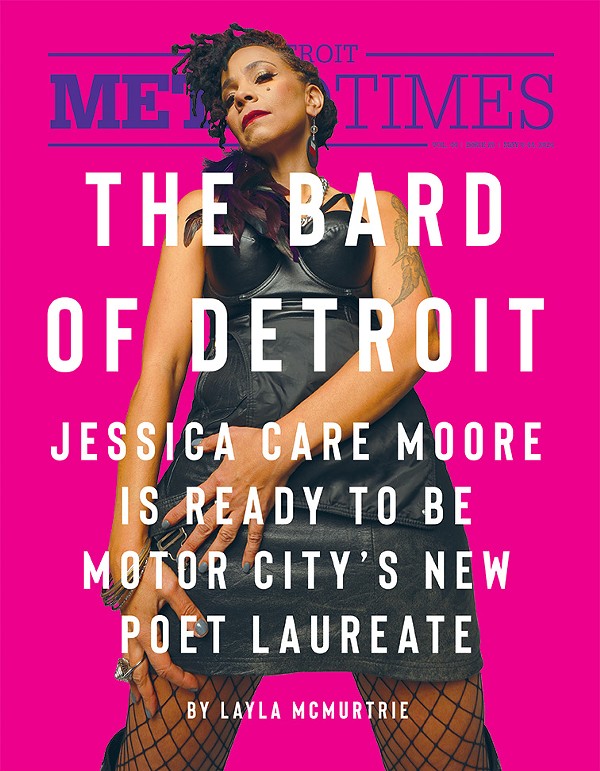Muhamer Malo’s oil paintings are idyllic, inviting, even a bit sentimental. One features a charming building on a cozy street at dusk in winter. Streetlights and windows glow warm and golden on a street you’d swear was cobblestone, beneath a blanket of snow.
At first glance, the painting looks like Europe. Yet at second glance you discover this painting, titled, "Downtown Birmingham," portrays the Townsend Hotel.
Birmingham is certainly charming but the Townsend has never been this enchanting; neither have snow-capped bungalows in Royal Oak nor boat scenes at Metro Beach, which Malo renders more like the Adriatic Sea.
The paintings, now on display in the exhibit, I Am Malo, at Café de Troit in downtown Detroit, include a few landscapes of Malo’s native Albania, a nude and a couple of abstract paintings. But mostly they pay homage, some arguably through rose-colored glasses, to this country, where Malo has long dreamed of living.
Malo came to Michigan, where he has cousins, after winning a lottery in 2000 that gave him passage out of Albania.
For most of his 47 years he lived under Communist rule in the southeastern European nation bordering the Adriatic and Ionian seas, between Greece and Serbia and Montenegro. After the fall of Communism in 1991, Albania was fraught with corruption, high unemployment and crime.
"Everything was destroyed — factory, company, no job, no lights, no water," says Malo.
Even today, according to the CIA’s World Factbook, Albania has the poorest telephone service in Europe with fewer than two telephones per 100 inhabitants.
Now living in a Royal Oak apartment with his wife and two children, Malo is trying to recapture the success he had as a painter in Albania. His wife supports the family working at a Birmingham dry cleaner, and he has struggled to find work in manufacturing.
In Albania, Malo majored in art in high school and at a four-year college in Korce, Albania. He had four exhibitions that were featured on major Albanian television stations and reviewed in Albanian newspapers. His works hang in collections in Europe, Canada and the United States, he says. But here, he’s working to build a name, and to provide for his family.
According to fellow artist Victor Pytko, Malo’s paintings sold in Europe for five times what he’s asking now. The prices at the Café de Troit show range from $750 to $1,950. Pytko has taken the painter under his wing and is helping to promote him.
In Michigan, Malo has already had two solo and five group shows. His most recent show was last February at the Royal Oak Library. He won honorable mention awards in 2002 and 2003 at the Farmington Hills Cultural Center art show. This is his first show in Detroit.
Like Pytko, Malo is a plein air painter, that is, he sets up his easel outside. Despite his broken English, Malo easily communicates with passersby.
"I remember the night I made this painting," Malo says of "Downtown Birmingham." "It was a wonderful night and the people around stayed with me."
Malo, a short, sturdy man wearing a blue polo shirt at his show’s opening, waxes poetic about his paintings.
"It’s very impressive," he says looking at one. "I love it. It’s very beautiful."
But it’s not the paintings he’s referring to so much as what he sees in the scenes: the nature, the beauty.
In "Autumn in Albania," a painting of a scene near his former home, Malo’s black lake reflects the landscape with broad strokes of blues, whites, oranges and greens. His leafless trees are simple forms, colorful splotches with no trunks.
"I don’t like detail," he says. "God is for detail. I am a painter."
An impressionistic painter, Malo applies thick gobs of paint in a technique called impasto. He’s spontaneous and fast, often completing a painting in two or three hours, much like Vincent Van Gogh.
Interestingly enough, some of Malo’s works resemble those of the Masters. More than one is similar in style to a Van Gogh. His nude resembles a Modigliani. Some paintings are reminiscent of Monet. Yet Pytko says it’s unlikely Malo was inspired by any of them.
"Malo told me that he was not exposed to the same artists we have been," says Pytko, who has given Malo books so he can read up on contemporary and historic artists.
One reason Pytko has taken an interest in Malo is "because this area needs as many perspectives as possible in terms of art," he says. "Malo sees the Detroit perspective and they see his perspective based on an Albanian experience and education. He has a different approach."
Pytko says while locals might see decay in Detroit, "Malo sees the renewal."
Malo never painted a tall building before he came to Detroit. One painting looks west down Larned Street to the Comerica Building and Coleman Young Municipal Center, which Malo narrowed to sneak in some of Canada’s skyline.
The palette of the Detroit paintings is cooler and has a more contemporary feel than many of his others paintings, which carry more intense contrasts and richer, earthier colors.
Pytko describes the richer palette as one Malo developed in Albania because of the atmosphere there.
"He still uses that palette here, even though the atmosphere is different… We sense color differently. He hasn’t been tainted yet," he adds with a laugh.
"Slowly his eye will change and become more accustomed to the color of the sky and the sun and the atmosphere here."
Let’s hope that’s not too soon.
The show runs throughout May at Cafe de Troit, 1260 Library St., just east of the former Hudson’s site. Café de Troit is open Monday-Friday, 6:30 a.m.-9 p.m., Saturday 8 a.m.-6 p.m. and Sunday 10 a.m.-6 p.m. Visit www.cafedetroit.com for more information.
Ellen Piligian is a freelance writer. E-mail [email protected]
